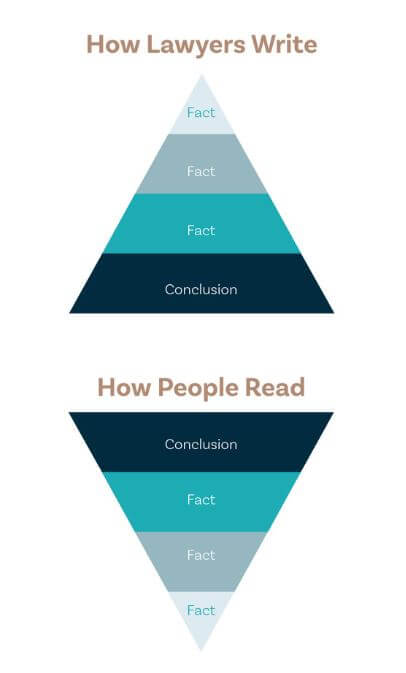It’s no secret that effective communication through content marketing is a key part of the marketing and business development strategy for every attorney and law firm. Yet research shows that 93-percent of blogs don’t get read by clients, prospects and key contacts. Why?
Well, a study by Microsoft says that people decide whether or not to read something online in as little as four seconds. Quite frankly, a lot of lawyer-written content doesn’t offer contacts what they want to read. I’ve seen the results of proprietary research into why blogs and articles don’t get read and the results are somewhat shocking. Here’s why clients say they don’t bother:
WHY CLIENTS DON’T READ YOUR BLOG
Not useful to my work: 88%
Too technical: 72%
Not timely: 59%
too long: 38%
The total exceeds 100% because multiple reasons could be listed. But here’s the really disheartening news: Responses were the same from CEOs and other executives, entrepreneurs, directors, managers, and general counsel. In many cases, not even other attorneys like reading blogs that their lawyers write.
 Why is this? Because the way attorneys are taught to write in law school is the exact opposite of how people read, assimilate and remember information. When writing a pleading, a memorandum, a brief, or a merger agreement, lawyers are trained to provide a list of facts first (whereas) and then state the conclusions (therefore). But readers need to know the conclusion first, and then absorb the supporting information. Writers calls this “flipping the pyramid.
Why is this? Because the way attorneys are taught to write in law school is the exact opposite of how people read, assimilate and remember information. When writing a pleading, a memorandum, a brief, or a merger agreement, lawyers are trained to provide a list of facts first (whereas) and then state the conclusions (therefore). But readers need to know the conclusion first, and then absorb the supporting information. Writers calls this “flipping the pyramid.
We often remind attorneys that content is about the music, not the words. Said differently, attorney blogs, articles, social posts, the summary on your LinkedIn profile, and other tools you use to build your reputation and increase your name recognition need to tell a story and not simply convey a lot of facts.
PSM writer, Jim Bliwas, once worked with a group of patent attorneys in California who needed an aging website rewritten and a weekly blog launched. Before writing anything, Jim asked them to explain what they do for clients.
After several mind-numbing minutes hearing about the intricacies and complexities of patent law, Jim professionally interrupted the attorneys, stating, “I’m lost.” He added, pretend I have no knowledge of your practice and just tell me a story about what you do.”
They were taken aback but regrouped and started telling stories about what, how and why patent lawyers do what they do, and how their work helps clients protect their valuable intellectual property. Bingo!
This is a good example of how stories can be the powerful music that explains the key value you and your firm bring to clients without having to expound on your high-level education or detailed experience in a complex field. As important, our analytics show that potential clients spend far longer on a webpage or blog if it’s explained as a story. We know attorneys have great expertise, yet they need writers to turn that knowledge into a story.
Top 10 Ways to Attract More Readers to your Blog
Besides telling stories, please consider the following top ten ways in which to attract more readers to your blog.
No. 1: Use strong headlines. A good headline attracts readers, a bad one drives people away. Keep it short, well-crafted and give readers a reason to go on.
No. 2: Entice readers in the first paragraph. It’s called the “lead” and a good one summarizes the entire piece and entices a visitor to continue. Far too many blogs begin with a long recitation of facts, or unnecessary background information. Follow Mark Twain’s advice and use the opening to “tell ‘em what you’ll tell ‘em” (sic) so a reader goes on.
No. 3: Use present tense and active voice. Both convey immediacy while the past tense disconnects readers from your topic. It’s because TV news has accustomed people to active voice. It’s not always possible to do but try as much as possible.
No. 4: Write in short, declarative sentences. After you compose a thought, say it out loud. If you run out of breath before you run out of words, the sentence is too long. Also, if there are three or more commas in a sentence, it’s probably too long.
No. 5: Write for the ear. Inside their head, most readers hear what their eyes are scanning. Writing for their ear makes it much easier to hold the thread of your blog. Read your blogs out loud before you publish them.
No. 6: Use word pictures. A word picture lets your reader “see” what they’re reading. It allows you to paint a picture in the reader’s mind using vivid visual imagery.
No. 7: Include anecdotes to explain details. Anecdotes and examples make it easier for readers to relate to the topic and help humanize the writing – and you. Client names aren’t needed. An example can be as non-specific as “For one client, this change meant…”
No. 8: Present ideas, not just facts. This is tough for many lawyers but blog readers want to know what they should be thinking about, not simply what a law, regulation or decision says. As one C-suite exec commented during a focus group, “If I wanted to know all about the law, I’d have gotten a Juris Doctor not an MBA.”
No. 9: Write the way people talk. Grammar rules are strict, but people don’t speak in fully grammatical sentences. It’s alright to begin sentences with “and,” “but,” “indeed” and moreover. Your second-grade teacher may disapprove but readers won’t.
No. 10: Never use footnotes or include citations. Blogs aren’t law review articles. Embedding links to relevant websites makes footnotes and case citations unnecessary.
No one expects your blog to read like Hemingway. But with content so important to retaining and attracting clients, you need to get more than 7-percent of your valuable contacts to read what you have written. Terrie S. Wheeler, MBC










